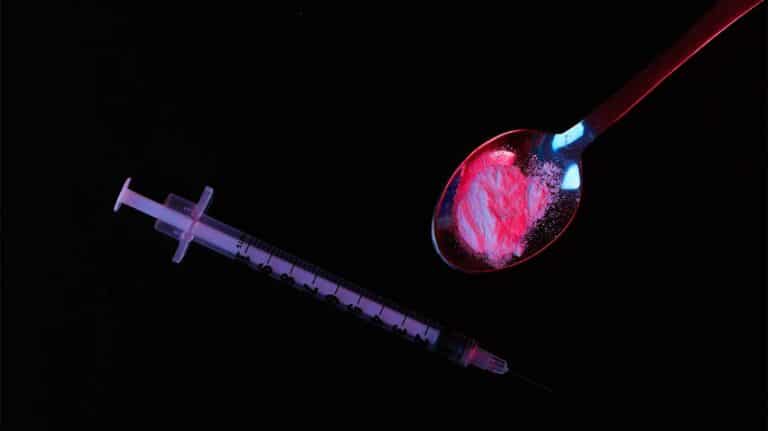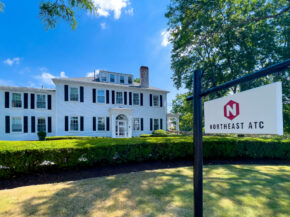Pink (U-47700) | Effects, Risks, & Signs Of Pink Heroin Addiction

Pink is an informal name for the synthetic opioid U-47700 (chemical name 3,4-dichloro-N-[2-(dimethylamino)cyclohexyl]-N-methylbenzamide). This drug was created as an experiment.
In the 1970s, The Upjohn Company made several novel synthetic opioids intending to find a non-addictive opioid analgesic (painkiller). These drugs were referred to as U-compounds or, less formally, “utopioids.”
U-47700 is almost eight times stronger than morphine. Until 2016, it was legal in most states.
After dozens of overdose deaths across the country, the US Drug Enforcement Administration (DEA) labeled pink heroin as a Schedule I controlled substance. It’s now an illicit drug because it has no legitimate medical use and is highly addictive.
Despite these dangers, you can still find U-47700 on the dark web or the street. It comes as a light pink powder, nasal spray, or pill.
Pink (U-47700) Effects
Pink is an opioid receptor agonist like heroin and other synthetic opioids, such as oxycodone (OxyContin). It activates the μ-opioid receptor, slowing down the central nervous system and changing how the brain perceives pain.
The effects of pink heroin are similar to the effects of other opioids:
- euphoria
- relaxation
- drowsiness
- sedation
- small pupils
- slowed breathing
- decreased heart rate
Adverse side effects of U-47700 may include:
- dizziness
- nausea
- vomiting
- bladder not fully emptying (urinary retention)
Some reports claim the designer drug is “extremely toxic, even in small doses,” and that it can fuel psychotic disorders and disconnection from reality.
Risks Of Pink Heroin Abuse
Since pink heroin is an illegal substance, it isn’t made safely like prescription drugs. That means you can’t be sure what’s in it or how strong it is. Risks of pink heroin abuse include opioid overdose, addiction, and criminal consequences.
Pink (U-47700) Overdose
You can overdose on U-47700 by taking too much at once, taking overlapping doses, or mixing it with other drugs. Central nervous system depressants, such as opioids, benzodiazepines, and alcohol, intensify the effects of pink heroin and raise the risk of overdose.
Pink (U-47700) overdose symptoms include:
- confusion
- lack of coordination
- cold, clammy skin
- blue skin, lips, or nails
- slow or shallow breathing (respiratory depression)
- loss of consciousness
- coma
An overdose of pink heroin can be fatal. You may be able to use naloxone (Narcan) to temporarily reverse overdose symptoms while you call for medical help.
If you buy prescription opioids on the street or online, you risk overdosing on U-47700.
Counterfeit Pills
In 2016, law enforcement seized 500 fake blue OxyContin pills in Ohio that contained U-47700 instead of oxycodone. In 2018, a woman in Georgia made counterfeit oxycodone pills with U-47700 and fentanyl in them.
You don’t know what’s in pink heroin pills, either. Often, illicit opioids contain new synthetic opioids such as fentanyl or fentanyl analogs (like furanyl fentanyl). Fentanyl is a potent opioid that’s 50 times stronger than heroin and responsible for most overdose fatalities today.
Pink (U-47700) Addiction
Like any opioid, pink heroin is addictive. It makes your brain release endorphins to relieve pain and dopamine to produce a sense of well-being. Dopamine is a reward hormone that reinforces a behavior, such as drug-taking.
After you take pink heroin for a few days, your brain will begin to adapt. It will produce less dopamine naturally and rely more on the drug. Your body will likely start depending on the opioid to function. It only takes a short time for physical dependence and addiction to develop.
Criminal Consequences Of Pink Heroin Abuse
The US government created the controlled substances act to protect people from abusing dangerous substances. Since pink heroin is a Schedule I controlled substance, it has the most severe criminal consequences. You’ll face fines or jail time if you have it in your possession.
The severity of your sentence depends on the state you live in, as well as your intention and how much of the drug you have. If you have a small amount of U-47700 you intend to use yourself, the consequences should be lighter than if you have a large amount that you intend to sell.
Signs Of Pink Heroin Addiction
If you’re concerned that a loved one is abusing pink heroin, or you’re wondering if you are addicted to it, there are several red flags to look for.
Signs of pink heroin addiction include:
- light pink powder or residue on clothes or possessions
- paraphernalia for snorting (straws, mirrors, razors)
- paraphernalia for drug injection (syringes, cook spoons, tourniquets)
- unidentified pills in unmarked containers
- using street names like “pink,” “pinky,” “China white,” or “U4”
- a constant state of sedation
- loss of interest in hobbies
- poor work or school performance
- secretive behavior
- spending time with people who do drugs
- borrowing or stealing money to pay for pink heroin
- excessive time spent seeking, using, and recovering from pink heroin
- continued U-47700 use despite negative consequences
All these signs don’t have to be present to indicate addiction, and just one sign may not be enough. But you know yourself or your loved one. You’ll know if the problem is real.
Pink (U-47700) Addiction Treatment
Pink heroin addiction treatment often starts with medical detox. The opioid withdrawal process can be dangerous, so inpatient medical detox programs provide 24-hour monitoring and support.
After detox, addiction treatment for U-47700 likely includes behavioral therapy and a variety of treatment methods that nurture the mind, body, and spirit.
Many people with pink heroin addiction can benefit from medication-assisted treatment (MAT). MAT uses medicine to reduce opioid cravings and withdrawal symptoms that often lead to relapse. The medicine is combined with therapy for a whole-person approach to healing.
At Ark Behavioral Health, we offer personalized treatment plans with evidence-based therapies and treatment options like:
- process groups
- peer support
- art therapy
- yoga and meditation
- fitness programs
- nutritional support
- medical detox
- medication-assisted treatment
To learn more about pink (U-47700) addiction and treatment, speak with one of our treatment specialists today. Your call is free and confidential, and we’re here to answer your questions and guide you to recovery.
Written by Ark Behavioral Health Editorial Team
©2024 Ark National Holdings, LLC. | All Rights Reserved.
This page does not provide medical advice.
CNN health - This legal opioid is leaving a lethal trail in the US
Cureus - U-47700: An Emerging Threat
Drug Enforcement Administration - Controlled Substances
Federal Register - Schedules of Controlled Substances: Placement of Butyryl Fentanyl and U-47700 Into Schedule I
MDPI - U-47700 and Its Analogs: Non-Fentanyl Synthetic Opioids Impacting the Recreational Drug Market
Questions About Treatment?
Ark Behavioral Health offers 100% confidential substance abuse assessment and treatment placement tailored to your individual needs. Achieve long-term recovery.
100% confidential. We respect your privacy.
Prefer Texting?
Our friendly support team is here to chat 24/7. Opt out any time.







 Learn More
Learn More








